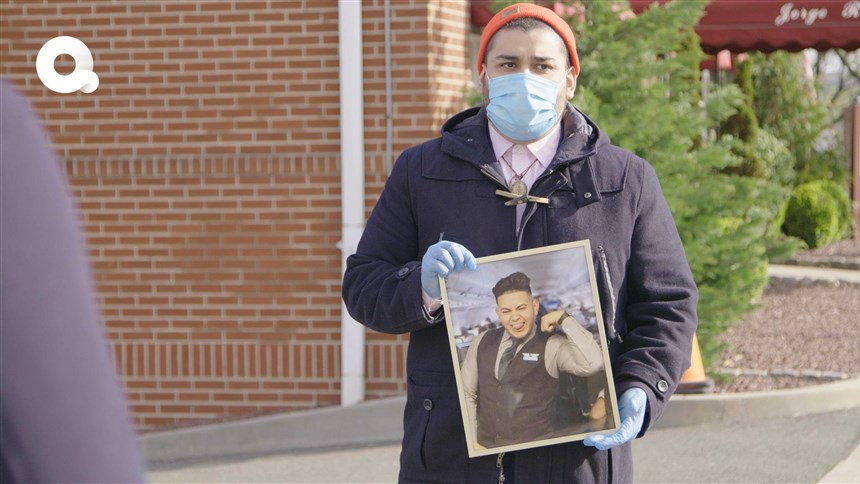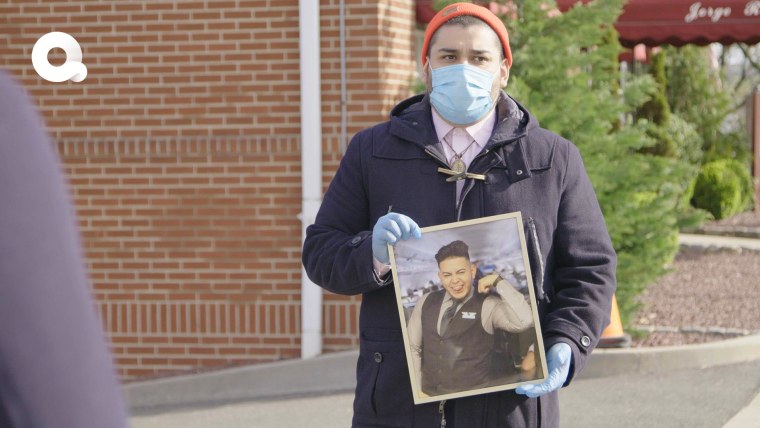Faith, family and plasma: How one man survived ‘the horror of COVID-19’

Room 5 of the COVID-19 critical care unit was largely silent, save for the occasional alarms from machines keeping Ron Panzok alive.
Few people entered the room. Physical examinations were limited to once per day to reduce the chances of spreading the coronavirus responsible for putting Panzok, 66, of New York City, in North Shore University Hospital, part of Northwell Health, on Long Island in mid-March. Hospital restrictions prevented his family from visiting.
Full coverage of the coronavirus outbreak
It's unlikely that the silence bothered Panzok; he was in a coma, responding to neither doctors nor the therapy meant to help him beat the virus wreaking havoc in his body.
Grieving from afar
April 28, 202006:05
Several times a day, though, Panzok's room would fill with the sound of familiar, loving voices, often singing familiar, happy songs.
"Sweeeeet Caroline! Bah bah bahhhh... Good times never seemed so good. (So good! So good!)"
Panzok's large extended family — his wife, children, siblings, cousins — called his room multiple times a day to sing, to pray, to talk about nothing in particular, and sometimes, yes, to play his favorite Neil Diamond song.
A nurse would put the phone on speaker, leaving the line open for an hour or more.
During Passover, the family serenaded him with "Dayenu," a traditional and jubilant song from the holiday's seder. "Who could forget 'Dayenu'?" Panzok's daughter, Amy Harel, said as she chuckled at the memory. "We would try anything just to see what would help wake him up."

Panzok's physician at North Shore University Hospital said strong connections to family or friends are an important component of intensive care, even for patients in a coma.
"I am a firm believer in a positive environment and family being at the bedside encouraging the patient. The horror of COVID-19 is that it took away most of that," said Dr. Hugh Cassiere, director of the hospital's cardiothoracic intensive care unit, which has been transformed into a COVID-19 ICU.
Panzok was one of the first COVID-19 patients Cassiere treated. He arrived by ambulance March 19, just 18 days after New York health officials had announced the state's first case. The week before he was hospitalized, Panzok had symptoms typical of the coronavirus: fever, cough, weakness, muscle aches, nausea, diarrhea.
The virus had spread to at least five other family members, including Harel, but it was Panzok who deteriorated, developing shortness of breath. When he arrived at the emergency room, his kidneys had started to fail. His lungs were so stiff and hard that physicians had to use three sedatives — essentially paralyzing his body — to get him on a ventilator.
I am a firm believer in a positive environment and family being at the bedside encouraging the patient. The horror of COVID-19 is that it took away most of that.
There was no clear treatment strategy. Another doctor had already given Panzok hydroxychloroquine, which studies at the time hinted might benefit COVID-19 patients. It didn't work. (Later studies found the drug did not help and may, in fact, harm patients.)
Panzok's damaged kidneys meant he wouldn't qualify for an experimental antiviral drug, remdesivir, because it had been shown to impact renal function.
Cassiere told Harel he needed her to help prepare the family for Panzok's death. Harel refused to accept such an outcome.
"He was not ever the kind of person who would give up. So we were never going to give up on him, ever," Harel said.

She described for Cassiere the reasons why her father needed to live, including six grandchildren he adored, plus a set of twin grandkids due any day. She described a kind, generous man who worked two jobs so Harel, 33, of Fairfield, Connecticut, could go to school to become an orthodontist.
"We need to do anything we possibly can to try and keep him alive," Harel recalls saying. "Even if there are risks to trials or drugs, we need to try it, because if the alternative is death, it doesn't matter."
"I was distraught by the end of the conversation," said Cassiere, who has more than two decades of experience with families whose loved ones are at the end of their lives. That emotional conversation, plus the ensuing deluge of COVID-19 patients in his critical care unit, has lead to many sleepless nights for the doctor.
"It's a constant emotional bombardment," Cassiere said. "You can't detach yourself. It's impossible."
Before the pandemic, Cassiere's department was focused on critically ill people with major heart problems, such as aortic aneurysms and heart attacks that required surgery. He estimated that 75 percent of his critically ill patients were eventuallywell enough to be discharged.
"I'm used to taking care of medically complex patients," Cassiere said.
His skills were prepared for a pandemic. His emotions were not.
Once the coronavirus took hold, he said, "100 percent of patients" were like Panzok, with slim odds of ever getting off the ventilator.
"It's a constant emotional bombardment," Cassiere said. "You can't detach yourself. It's impossible."
Cassiere recalled a study published just a month earlier in The Lancet, which suggested high doses of a steroid called dexamethasone could help patients with acute respiratory distress syndrome get off ventilators more quickly, and reduce deaths.
But he was concerned steroids would do more harm than good. Some research from the 2003 SARS outbreak suggested that coronaviruses linger longer in patients who received steroids to reduce inflammation in their lungs.
To counter that possibility, Cassiere decided to explore using convalescent plasma, the antibody-rich blood product of recovered COVID-19 patients. That just might be enough to counter the virus, he thought.
"I call it the one-two punch," he said. He started Panzok on the steroids and waited. Panzok would need to show an improvement on the drugs before moving onto the convalescent plasma.
"If he didn't improve, there's really no other option, and we would have to just make him comfortable," he said.
Download the NBC News app for full coverage of the coronavirus outbreak
Cassiere wasn't certain he'd see improvement; he'd tried the steroids in other patients in similar situations, and they only worked about half the time. But Panzok's lungs, it turned out, responded dramatically. Even so, he still wasn't reacting to simple commands, like squeezing a doctor's hand.
Before doctors moved to the convalescent plasma, they did an MRI on Panzok's brain to make sure he hadn't suffered irreversible damage.
"COVID-19 can cause devastating strokes," Cassiere said. "I wanted to make sure I wasn't dealing with a patient that, although he responded to steroids, had had a stroke" that would make any further treatments useless.
The MRI showed a partial clot in one of the veins in Panzok's brain, but it wasn't dire. It was something doctors could treat. They moved ahead with the convalescent plasma, asking the Food and Drug Administration for authorization to use the treament, as the plasma is considered experimental.
Within a week of the plasma infusion, Panzok went from COVID positive to COVID negative.
The medications had done their job. He was weaned off the sedatives. But Panzok remained unresponsive.
"He would not wake up from the medically-induced coma," Harel, Panzok's daughter, said. "He was off of the sedation about a week or two, and he wasn't waking up."
In order for physicians to get Panzok off the ventilator, he needed to follow simple commands to prove he could breathe on his own.
Once again, his doctors spoke with his family about the possibility that there was nothing more they could do, other than place a tracheotomy tube into his throat as an alternative to the ventilator.
Harel recalled that physicians told her that in general, "Either the patients wake up right away, or they never wake up again."
Either the patients wake up right away, or they never wake up again.
"I refused to give in. I refused to give up," Harel said. The family enlisted large prayer groups. And they made sure Panzok, perhaps on some level, knew it.
That's when every day, multiple times a day, Panzok's nursing team would open up the phone line, providing the auditory tie to his family.
"We just kept trying" to connect with him, Harel recalled. The family even spoke in Hebrew, Panzok's first language. The prayers continued.
"I think if you are the kind of person who believes in God or has faith," Harel said, "you like to think there is a higher being."

Five weeks into his coma, Panzok started to move.
"First, he moved his hand. Then he moved his foot," Harel said. Doctors then capped the tracheotomy incision in his neck so he could speak.
A nurse called Panzok's wife, Bonnie, who was with Harel at the time, and asked him to say something to his family.
"He said, 'I love you, baby,'" and that was exactly what my father would always say," Harel said. He was back.
Eight weeks after he entered the hospital, Panzok was ready to leave.
It's going to take many weeks and months for Panzok to regain his previous strength. An avid cyclist, he used to go on 40-mile bike trips. He loved exercise and working out in the gym. All of that is gone.

He is now relearning to do the basics on his own: getting out of bed, swallowing. He's being weaned off of supplemental oxygen.
That is typical of most patients who've been in intensive care for many weeks, with little to no physical activity.
"We're seeing a lot of weakness, a lot of numbness, difficulty walking," said Dr. Susan Maltser, medical director of the department of physical medicine and rehabilitation at Glen Cove Hospital on Long Island, where Panzok is currently in rehabilitation.
Maltser's facility typically has 65 beds available for acute rehab patients, but has been able to expand to 75. Half are designated for post-ICU COVID-19 patients.
"The hospitals saw their peaks about three weeks ago," Maltser said. "We're seeing our peak right now because people who were in the ICU intubated are just getting to us."
Patients like Panzok get about three hours of rehabilitation therapy each day, for about three weeks. His doctors say he is getting stronger. But there is a long way to go, and he is acutely aware of that fact.

"He just said to me, 'I was a bull of a man. I drove a truck, and I carried boxes. Now, it's hard for me to move my arm all the way,'" Maltser said, recalling a conversation she had with Panzok this week.
But, she added, he is motivated to do the hard work necessary to get back to independence.
Harel, too, has faith. "He's not a complainer, ever," she said. "He has that 'can-do spirit.' He's a very hard working, positive person."
Follow NBC HEALTH on Twitter & Facebook.
 Pathways Drug Rehabilitation Luxury Addiction Treatment & Detox Center
Pathways Drug Rehabilitation Luxury Addiction Treatment & Detox Center




